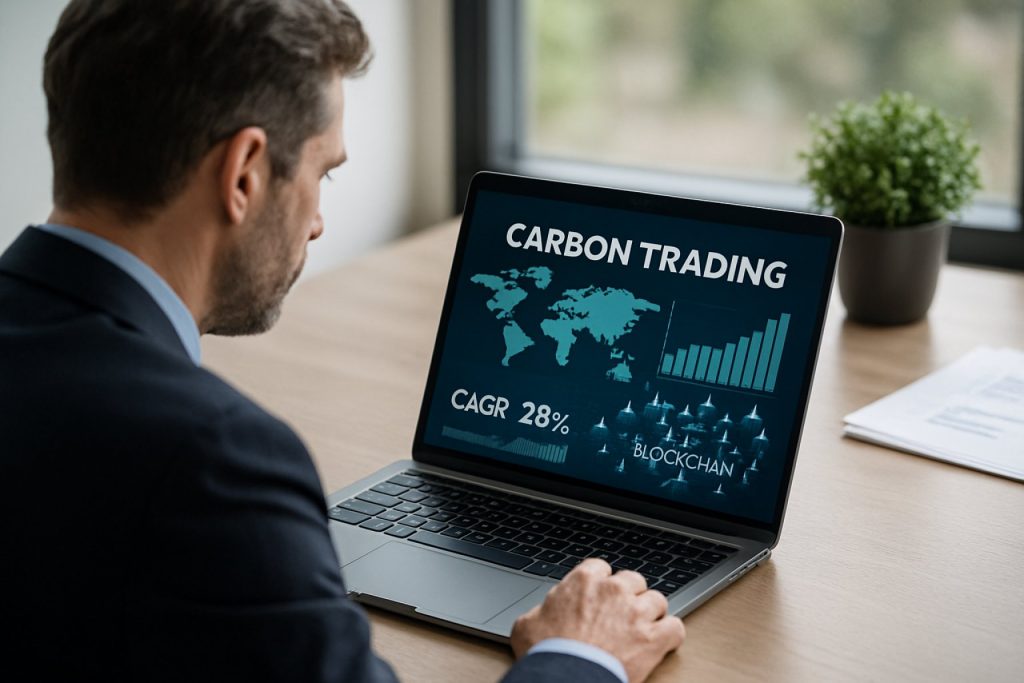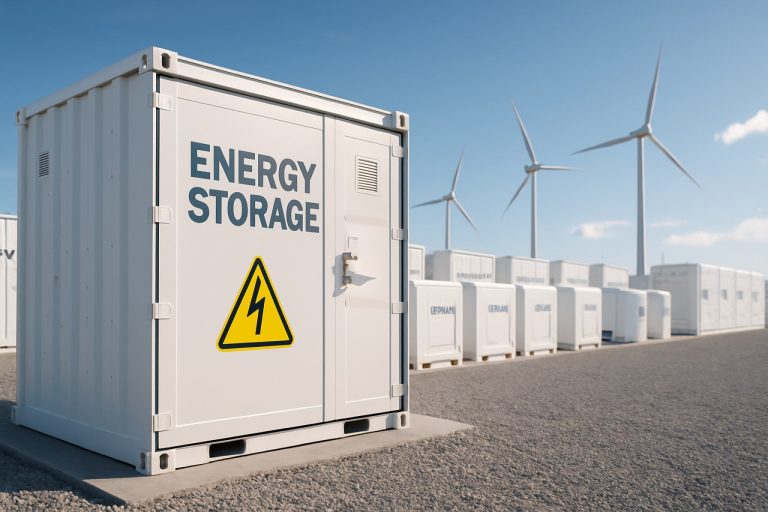
Distributed Ledger-Based Carbon Trading Platforms Market Report 2025: In-Depth Analysis of Blockchain-Enabled Carbon Markets, Growth Drivers, and Strategic Opportunities
- Executive Summary & Market Overview
- Key Technology Trends in Distributed Ledger Carbon Trading
- Competitive Landscape and Leading Platform Providers
- Market Growth Forecasts (2025–2030): CAGR, Volume, and Value Analysis
- Regional Analysis: Adoption and Regulatory Developments by Geography
- Future Outlook: Innovations and Market Evolution
- Challenges and Opportunities: Scalability, Interoperability, and Policy Impacts
- Sources & References
Executive Summary & Market Overview
Distributed ledger-based carbon trading platforms represent a transformative evolution in the global carbon markets, leveraging blockchain and other distributed ledger technologies (DLT) to enhance transparency, efficiency, and trust in carbon credit transactions. As of 2025, these platforms are gaining significant traction, driven by increasing regulatory pressure for climate action, corporate net-zero commitments, and the need for robust, tamper-proof systems to track carbon assets.
The global carbon trading market is projected to reach over $100 billion in value by 2025, with distributed ledger solutions playing a pivotal role in this expansion. DLT-based platforms address longstanding challenges in traditional carbon markets, such as double counting, lack of standardization, and opaque verification processes. By providing immutable records and real-time traceability, these platforms facilitate the issuance, transfer, and retirement of carbon credits with unprecedented integrity and auditability.
Key industry players, including IBM, Shell, and AirCarbon Exchange, have launched or partnered on blockchain-based carbon marketplaces, signaling strong institutional interest. For example, AirCarbon Exchange has reported a surge in transaction volumes, reflecting growing market confidence in DLT-enabled solutions. Meanwhile, initiatives like the IATA Aviation Carbon Exchange are integrating blockchain to streamline compliance for regulated industries.
Regulatory developments are also catalyzing adoption. The European Union’s Emissions Trading System (EU ETS) and emerging frameworks in Asia-Pacific are increasingly open to digital infrastructure that can support cross-border carbon credit trading and verification (International Energy Agency). Furthermore, the World Bank has highlighted the potential of distributed ledger technology to harmonize disparate carbon markets and foster global interoperability.
In summary, distributed ledger-based carbon trading platforms are poised to become foundational to the next generation of carbon markets. Their ability to deliver transparency, reduce transaction costs, and support regulatory compliance positions them as critical enablers of scalable, credible climate action in 2025 and beyond.
Key Technology Trends in Distributed Ledger Carbon Trading
Distributed ledger-based carbon trading platforms are rapidly transforming the landscape of carbon markets in 2025, leveraging blockchain and other distributed ledger technologies (DLT) to enhance transparency, traceability, and efficiency. These platforms enable the issuance, tracking, and trading of carbon credits on immutable digital ledgers, addressing longstanding challenges such as double counting, fraud, and lack of interoperability between registries.
One of the most significant trends is the integration of smart contracts, which automate the verification and settlement of carbon credit transactions. This reduces administrative overhead and accelerates the transfer of credits between parties. For example, platforms like KlimaDAO and Toucan Protocol have pioneered tokenized carbon credits, allowing for real-time trading and instant retirement of credits on public blockchains.
Interoperability is another key focus area. In 2025, leading platforms are developing cross-chain solutions and APIs to connect disparate carbon registries and trading systems. This enables seamless movement of carbon credits across different networks, fostering greater market liquidity and participation. The International Water Association and IOTA Foundation are among organizations working on standards to facilitate such interoperability.
Data integrity and auditability are being strengthened through the use of decentralized oracles and IoT integration. These technologies ensure that emissions data and project verification are securely and transparently recorded on-chain. For instance, Energy Web is collaborating with utilities and project developers to automate the reporting and validation of renewable energy and carbon offset data.
Regulatory alignment is also advancing, with platforms increasingly designed to comply with emerging standards from bodies such as the International Organization for Standardization (ISO) and the International Civil Aviation Organization (ICAO). This is critical for scaling voluntary and compliance carbon markets globally.
- Smart contracts automate and secure transactions.
- Interoperability solutions connect global carbon markets.
- Decentralized data sources enhance trust and auditability.
- Regulatory compliance is built into platform design.
As these trends converge, distributed ledger-based carbon trading platforms are poised to underpin a more robust, transparent, and scalable global carbon market in 2025 and beyond.
Competitive Landscape and Leading Platform Providers
The competitive landscape for distributed ledger-based carbon trading platforms in 2025 is characterized by rapid innovation, strategic partnerships, and increasing institutional adoption. As global carbon markets expand and regulatory frameworks mature, blockchain and distributed ledger technology (DLT) providers are vying to establish themselves as the backbone of transparent, efficient, and scalable carbon trading ecosystems.
Key players in this space include both established technology firms and specialized startups. IBM has leveraged its Hyperledger Fabric platform to support carbon credit tracking and trading, partnering with organizations such as Verra and the International Emissions Trading Association (IETA) to pilot interoperable solutions. ConsenSys has advanced Ethereum-based platforms, focusing on tokenization of carbon credits and smart contract automation to streamline verification and settlement processes.
Emerging platforms like Toucan Protocol and KlimaDAO have gained traction by integrating with voluntary carbon markets and enabling on-chain retirement and fractionalization of carbon assets. These platforms emphasize open access, composability, and interoperability, attracting both retail and institutional participants. Meanwhile, Carbonplace, a consortium of major banks, is developing a DLT-based settlement network to facilitate cross-border carbon credit transactions, aiming to address liquidity and trust issues in traditional markets.
The competitive dynamics are further shaped by collaborations with standards bodies and registries. For instance, Verra and Gold Standard have initiated pilot integrations with blockchain platforms to enhance traceability and reduce double counting. These partnerships are critical for ensuring that digital carbon credits meet rigorous environmental and regulatory standards.
- Interoperability: Leading providers are prioritizing interoperability with existing registries and other blockchains to maximize market reach and compliance.
- Scalability: Solutions are being designed to handle increasing transaction volumes as carbon markets grow, with a focus on minimizing energy consumption and transaction costs.
- Regulatory Alignment: Platforms are adapting to evolving regulations, such as the EU’s Carbon Border Adjustment Mechanism (CBAM), to ensure cross-jurisdictional compliance.
Looking ahead, the competitive landscape is expected to consolidate around platforms that can demonstrate robust security, regulatory alignment, and seamless integration with both legacy and emerging carbon market infrastructures.
Market Growth Forecasts (2025–2030): CAGR, Volume, and Value Analysis
The market for distributed ledger-based carbon trading platforms is poised for robust growth between 2025 and 2030, driven by increasing regulatory pressure, corporate sustainability commitments, and the need for transparent, efficient carbon markets. According to projections by MarketsandMarkets, the global blockchain carbon credit market—which encompasses distributed ledger-based trading platforms—is expected to grow at a compound annual growth rate (CAGR) of approximately 55% from 2025 to 2030. This rapid expansion is underpinned by the rising adoption of blockchain technology to address issues of double counting, fraud, and lack of transparency in traditional carbon markets.
In terms of market value, the sector is forecasted to reach a valuation exceeding USD 1.5 billion by 2030, up from an estimated USD 200 million in 2025. This surge is attributed to the proliferation of new platform launches, increased participation from both compliance and voluntary carbon markets, and the integration of distributed ledger technology by established exchanges and registries. Grand View Research highlights that the volume of carbon credits traded on distributed ledger platforms is expected to surpass 500 million metric tons of CO2 equivalent annually by 2030, reflecting a significant shift from pilot projects to mainstream adoption.
- Regional Growth: North America and Europe are projected to lead in market share, driven by stringent emissions regulations and advanced digital infrastructure. However, Asia-Pacific is anticipated to exhibit the fastest CAGR, fueled by emerging carbon markets and government-led digitalization initiatives.
- Platform Evolution: The period will see a transition from single-use, project-specific platforms to interoperable, multi-asset trading ecosystems, enabling cross-border transactions and integration with national registries.
- Market Drivers: Key growth drivers include the need for immutable audit trails, real-time settlement, and enhanced market access for small-scale project developers.
Overall, the 2025–2030 period is expected to mark a pivotal phase for distributed ledger-based carbon trading platforms, with exponential growth in both transaction volume and market value, setting the stage for a more transparent and efficient global carbon market landscape (Wood Mackenzie).
Regional Analysis: Adoption and Regulatory Developments by Geography
The adoption and regulatory landscape for distributed ledger-based carbon trading platforms in 2025 is marked by significant regional variation, shaped by differing policy priorities, technological readiness, and market maturity. These platforms, leveraging blockchain and other distributed ledger technologies (DLT), are increasingly recognized for their potential to enhance transparency, traceability, and efficiency in carbon markets.
In Europe, the European Union remains at the forefront, driven by its ambitious climate targets and the established European Union Emissions Trading System (EU ETS). The EU has actively supported pilot projects integrating DLT to improve the integrity of carbon credits and streamline cross-border transactions. Regulatory guidance from the European Securities and Markets Authority (ESMA) and the European Banking Authority (EBA) has provided clarity on the use of blockchain in environmental markets, fostering innovation while ensuring compliance with anti-money laundering (AML) and know-your-customer (KYC) requirements.
In North America, the United States exhibits a fragmented approach. While federal regulation remains limited, states like California—through the California Cap-and-Trade Program—have begun exploring DLT pilots to address double counting and improve market access. The Commodity Futures Trading Commission (CFTC) has issued advisories on digital asset trading, but comprehensive federal regulation for blockchain-based carbon markets is still evolving. Canada, meanwhile, is piloting DLT solutions in partnership with private sector consortia, supported by the Environment and Climate Change Canada agency.
Asia-Pacific is witnessing rapid adoption, particularly in China and Singapore. China’s national carbon market, overseen by the Ministry of Ecology and Environment, has initiated blockchain pilots to enhance data reliability and prevent fraud. Singapore, positioning itself as a regional carbon trading hub, has issued clear guidelines through the Monetary Authority of Singapore (MAS) and launched the Climate Impact X platform, which utilizes DLT for voluntary carbon credit trading.
In Latin America and Africa, adoption is nascent but growing, often supported by international organizations such as the World Bank and the United Nations Environment Programme (UNEP). These regions focus on leveraging DLT to improve access for small-scale project developers and enhance the credibility of credits in voluntary markets.
Overall, 2025 sees a patchwork of regulatory approaches, with Europe and Asia-Pacific leading in both adoption and regulatory clarity, while North America and emerging markets progress through pilot initiatives and evolving frameworks.
Future Outlook: Innovations and Market Evolution
The future outlook for distributed ledger-based carbon trading platforms in 2025 is shaped by rapid technological innovation, evolving regulatory frameworks, and increasing demand for transparent, efficient carbon markets. As global climate commitments intensify, these platforms are expected to play a pivotal role in scaling voluntary and compliance carbon markets, addressing persistent challenges such as double counting, lack of standardization, and limited market access.
Key innovations anticipated in 2025 include the integration of advanced smart contracts and interoperability protocols, enabling seamless transactions across multiple registries and jurisdictions. This is expected to reduce administrative overhead and settlement times, while enhancing trust among market participants. Leading technology providers and consortia are piloting solutions that automate verification and retirement of carbon credits, leveraging real-time data from IoT sensors and satellite imagery to improve the accuracy and credibility of emissions reporting (IBM; Energy Web Foundation).
Market evolution is also being driven by the entry of major financial institutions and corporates, who are seeking to meet net-zero targets and regulatory disclosure requirements. In 2025, distributed ledger platforms are expected to facilitate new financial products, such as tokenized carbon credits and derivatives, broadening market participation and liquidity. The emergence of secondary trading venues and decentralized exchanges is likely to further democratize access, particularly for small-scale project developers and buyers in emerging markets (Goldman Sachs; Climate Chain Coalition).
Regulatory clarity remains a critical factor for market growth. In 2025, ongoing collaboration between platform providers, standard-setting bodies, and regulators is anticipated to yield harmonized frameworks for digital carbon assets, addressing concerns around legal enforceability, anti-money laundering, and consumer protection (Institute of International Finance). The adoption of open standards and APIs is expected to accelerate, fostering interoperability and reducing fragmentation across the ecosystem.
Overall, distributed ledger-based carbon trading platforms are poised for significant expansion in 2025, underpinned by technological maturity, institutional adoption, and supportive policy developments. Their evolution will be instrumental in scaling credible climate action and unlocking new value streams in the global carbon economy.
Challenges and Opportunities: Scalability, Interoperability, and Policy Impacts
Distributed ledger-based carbon trading platforms are poised to transform the carbon markets in 2025, but their growth is shaped by a complex interplay of scalability, interoperability, and policy factors. Each of these dimensions presents both significant challenges and unique opportunities for stakeholders.
Scalability remains a primary concern as transaction volumes and participant numbers increase. Early pilot projects have demonstrated the technical feasibility of blockchain-based carbon trading, but scaling these solutions to national or global levels introduces issues such as network congestion, high transaction costs, and energy consumption. For example, platforms built on energy-intensive proof-of-work blockchains may face criticism for undermining environmental goals. However, the adoption of more efficient consensus mechanisms, such as proof-of-stake or layer-2 scaling solutions, is enabling platforms to process higher volumes with reduced environmental impact. According to World Economic Forum, these innovations are critical for supporting the anticipated surge in carbon credit transactions as more countries and corporations commit to net-zero targets.
Interoperability is another pivotal factor. The carbon market is fragmented, with multiple registries, standards, and trading systems operating in parallel. Distributed ledger platforms must enable seamless data exchange and asset transfer across these disparate systems to unlock full market potential. Efforts such as the International Water Association’s work on digital standards and the International Air Transport Association’s blockchain pilots for carbon offsetting illustrate the push toward harmonization. Interoperable platforms can reduce double counting, enhance transparency, and facilitate cross-border trading, but achieving this requires industry-wide collaboration and the development of common protocols.
- Policy Impacts: Regulatory uncertainty remains a double-edged sword. On one hand, clear and supportive policies can accelerate adoption by providing legal certainty and encouraging investment. The European Parliament’s moves to integrate blockchain into the EU Emissions Trading System (ETS) exemplify proactive regulation. On the other hand, inconsistent or restrictive policies across jurisdictions can fragment markets and stifle innovation. The evolving global policy landscape in 2025 will be a decisive factor in determining which platforms achieve scale and legitimacy.
In summary, while distributed ledger-based carbon trading platforms face significant hurdles in scalability, interoperability, and regulatory alignment, these same areas offer substantial opportunities for innovation and market leadership as the sector matures in 2025.
Sources & References
- IBM
- Shell
- AirCarbon Exchange
- IATA Aviation Carbon Exchange
- International Energy Agency
- World Bank
- KlimaDAO
- International Water Association
- IOTA Foundation
- Energy Web
- International Civil Aviation Organization (ICAO)
- IBM
- ConsenSys
- KlimaDAO
- Carbonplace
- Verra
- Gold Standard
- MarketsandMarkets
- Grand View Research
- Wood Mackenzie
- European Union Emissions Trading System (EU ETS)
- European Securities and Markets Authority (ESMA)
- European Banking Authority (EBA)
- California Cap-and-Trade Program
- Commodity Futures Trading Commission (CFTC)
- Environment and Climate Change Canada
- Ministry of Ecology and Environment
- Monetary Authority of Singapore (MAS)
- United Nations Environment Programme (UNEP)
- Goldman Sachs
- Institute of International Finance
- European Parliament



